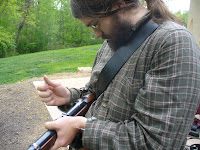I have been working on hand-sewing a new Colonial jacket, shift and petticoat. It has been moving very slow. The shift is completely sewn other than the two armbands at the bottom of the sleeves and my jacket is about halfway done. The jacket is taking a long time because the fabric and the lining are sewn separately so it is like sewing two jackets and putting them together. I am still not sure what color petticoat I should make. I originally thought that a nice checkered linen pattern would be pretty, but I ended up having blue and white linen fabric for my jacket, I now need a plainer petticoat. Above is a sketch of what I hope the finished dress will look like. (Sorry it is really not a good drawing, I was really just trying to see how it looked all put together. You'd never know I was an artist!) I am not sure about the maroon skirt, yet.
My shift is very plain, there is a diagram for a shift on A Stitch in Time at Home that is very easy to use. Linen wrinkles like crazy, sorry about the picture.
This is the the detail of the hand sewing on my shift. I very much like the look of hand-sewing. It is definitely not the best but it does make a prettier looking garment. I used to be afraid of hand-sewing. It really isn't that hard and you have a larger selection of stitches to choose from.
This is my jacket fabric. It is linen but was too thin so I have been lining it with a linen tablecloth. The fabric is pretty, but I think I will feel like a china plate wearing it. It was the only stamped, linen I could find, though.
So, will the maroon petticoat look nice or will it look to "old timesy patriotic?" The other option I have been thinking about is possible blue and white stripes (run vertically.) Any other ideas? I am hoping to finish the outfit in time for reenacting season.
My shift is very plain, there is a diagram for a shift on A Stitch in Time at Home that is very easy to use. Linen wrinkles like crazy, sorry about the picture.
This is the the detail of the hand sewing on my shift. I very much like the look of hand-sewing. It is definitely not the best but it does make a prettier looking garment. I used to be afraid of hand-sewing. It really isn't that hard and you have a larger selection of stitches to choose from.
This is my jacket fabric. It is linen but was too thin so I have been lining it with a linen tablecloth. The fabric is pretty, but I think I will feel like a china plate wearing it. It was the only stamped, linen I could find, though.
So, will the maroon petticoat look nice or will it look to "old timesy patriotic?" The other option I have been thinking about is possible blue and white stripes (run vertically.) Any other ideas? I am hoping to finish the outfit in time for reenacting season.

























